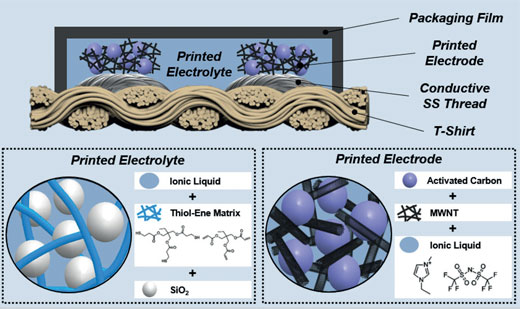| Posted: Jan 19, 2018 | |
Power up your T-shirt with print designs |
|
| (Nanowerk Spotlight) The ultimate goal for wearable electronics is to make them fully integrated with your clothes, shoes and accessories so that they become indistinguishable from the actual garment. These electronic textiles with the ability to sense, act, store, emit, and move, will act as displays, communication devices, biomedical and environmental sensors, man-machine interfaces and of course game controllers (read more about this in our Nanowerk Spotlight section on electronic textiles and wearable computing). | |
| Of course, these electronic garments need rechargeable power sources in order to function in a day-to-day environment. Not to forget, these clothes should be able to withstand their exposure to laundering, wringing, ironing, and folding. | |
| Inspired by the designs printed on T-shirts, researchers in South Korea recently reported a new class of wearable power sources. | |
| "To explore the feasibility of power sources directly printed on cotton T-shirts, which look like letters or symbols, we chose electric double layer supercapacitors based on activated carbon materials as a model electrochemical system," Prof. Sang-Young Lee, Head of the School of Energy and Chemical Engineering at Ulsan National Institute of Science and Technology (UNIST), tells Nanowerk. "Our T-shirts look and behave like a normal T-shirt but feature printed supercapacitors in the shape of letters and symbols." | |
| This research has been published in Advanced Functional Materials ("Wearable Supercapacitors Printed on Garments"). | |
 |
|
| Schematic representation illustrating the major components of the supercapacitor-printed T-shirt (SS thread current collector, printed electrode (AC/MWCNT/ionic liquid), printed gel electrolyte (ionic liquid/thiol-ene polymer network skeleton/SiO2 nanoparticles), and packaging film). (Reprinted with permission by Wiley-VCH Verlag) | |
| Earlier this year, the team from Prof. Lee's Energy Soft Materials Lab have demonstrated ink-jet printed supercapacitors on paper. This process involves using a conventional inkjet printer to print a preparatory coating onto a normal piece of paper. Next, an ink of activated carbon and single-walled nanotubes is printed, followed by an ink made of silver nanowires in water. These two inks form the electrodes. | |
| In their new work, the researchers printed the supercapacitors directly on cotton T-shirts via the UV curing-assisted stencil printing. The printed supercapacitors, which consist of printed electrodes (activated carbon + multiwalled carbon nanotubes + ionic liquid) and printed gel electrolytes (ionic liquid + thiol-ene polymer network skeleton + SiO2 nanoparticles), were monolithically integrated with the T-shirts and looked like typical letters or symbols commonly printed on T-shirts. | |
| The scientists report that this printing process does not require traditional processing solvents, time-/energy-consuming drying steps, the injection of liquid electrolytes, and conventional porous separator membranes. | |
| "We tuned the rheological properties of the printable electrode/electrolyte pastes via ionic strength adjustment based on our understanding of the SiO2 colloidal network structure, which played a vital role in the printability and formation of the ion/electron transport channels," Lee notes. | |
| He points out that the supercapacitor-printed T-shirts maintained their shape and dimensions without impairing the electrochemical activity upon exposure to the laundering, wringing, ironing, and folding often encountered in daily clothing. | |
 |
|
| Photographs and a conceptual illustration of the bulb symbol-shaped supercapacitor (3.0 V/1.5 F (15 mF cm-2), scan rate = 2.0 mV s-1) that powered an LED lamp. The supercapacitor was directly printed on a white T-shirt and connected to the LED lamp using conductive stainless steel thread. (Reprinted with permission by Wiley-VCH Verlag) | |
| The team's future work will focus on further improving the electrochemical performance of their printed supercapacitors and extending the application toward newly emerging power sources. Currently, they are developing 3D-printed power sources and are trying to develop form factor-free, printed power sources using advanced printing technologies. | |
| "We envision that the supercapacitor-printed T-shirts hold great promise for the forthcoming wearable electronics era as an effective/scalable electronic garment platform which lies far beyond those achievable with conventional textile-based battery technologies," Lee concludes. | |
 By
Michael
Berger
– Michael is author of three books by the Royal Society of Chemistry:
Nano-Society: Pushing the Boundaries of Technology,
Nanotechnology: The Future is Tiny, and
Nanoengineering: The Skills and Tools Making Technology Invisible
Copyright ©
Nanowerk LLC
By
Michael
Berger
– Michael is author of three books by the Royal Society of Chemistry:
Nano-Society: Pushing the Boundaries of Technology,
Nanotechnology: The Future is Tiny, and
Nanoengineering: The Skills and Tools Making Technology Invisible
Copyright ©
Nanowerk LLC
|
|
|
Become a Spotlight guest author! Join our large and growing group of guest contributors. Have you just published a scientific paper or have other exciting developments to share with the nanotechnology community? Here is how to publish on nanowerk.com. |
|
